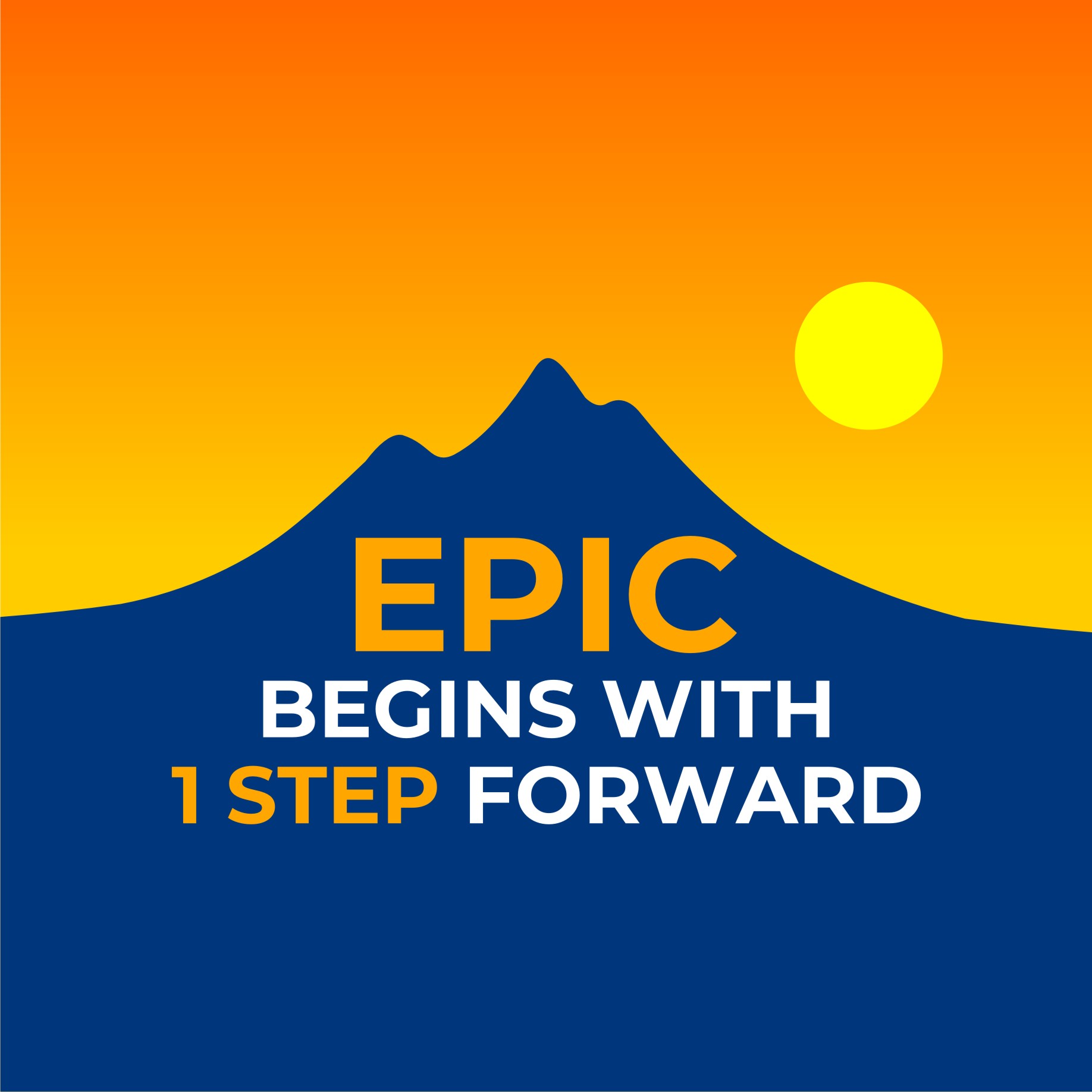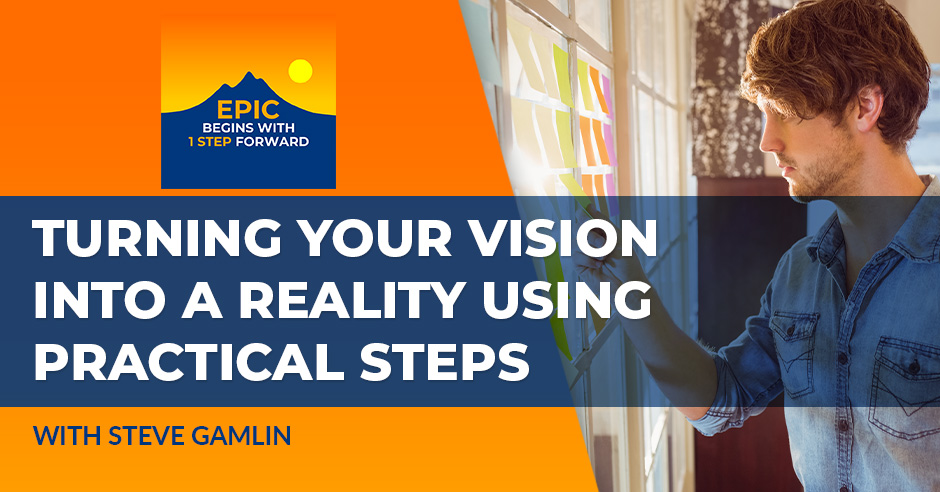—
Watch the episode here
Listen to the podcast here
Turning Your Vision Into A Reality Using Practical Steps With Steve Gamlin
Introduction And Guest Background
Welcome back to another exciting episode. I have Steve Gamlin with me. Steve, tell me who you are and what you do.
Thank you, Zander. I am a keynote speaker. I should say I’ve enjoyed life as a keynote speaker. Also, a visualization coach, creator of the Vision Board Mastery Learning Program, former radio personality, former stand-up comedian, and, so far, a four-time self-published author.
Understanding Vision Boards
That is awesome. Welcome. Steve and I share quite a few things in common. I, too, have done stand-up comedy. I, too, am a keynote speaker. I, too, have published three books. This is great. I’m sure we’re going to have a lot to talk about. I wanted to start off with, you said a vision board. You talk about vision boards. I love vision boards. Tell my audience and me what vision boards mean to you, what you teach about, and other stuff.
The simplest definition for me is that somebody asked me one time, “Steve, what is a vision board?” I said, it’s a wall-mounted GPS for the rest of and the best of your life, from where you are now to where you want to be. The big thing for me, and this is the reason I teach the way I teach it, is to stop sending me pictures of your vision board starter kit, which is a letter to Santa Claus, Lamborghini, yacht, private jet, mansion, helicopter, big honking gold watch, and a bank vault full of gold bars and piles of cash.
A vision board is a GPS for the rest of your life. It guides you from where you are now to where you want to be.
Don’t tell me necessarily what you want. Tell me who you want to become, and that’ll be part of the journey as well. That’s the big thing that sets me apart from a lot of the other people out there who are having their vision board parties with wine, cheese, crackers, scissors, glitter, and glue sticks and the work that my clients and I get to do.
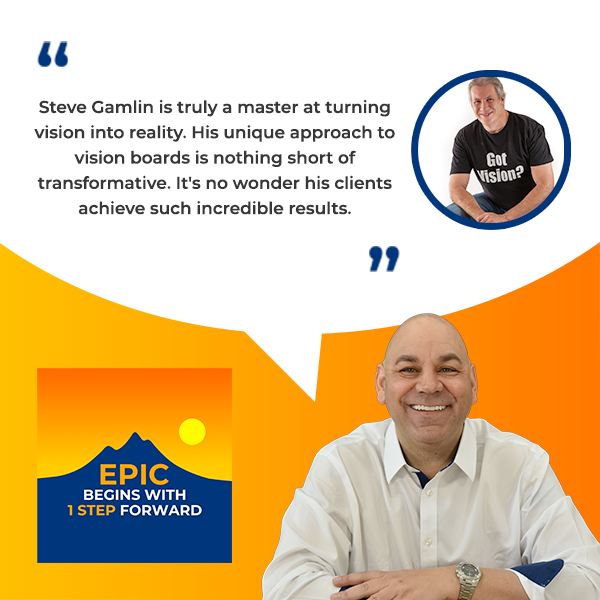
Definitely. I love vision boards. I talk about how important they are in my book. I do one every year. I will say, I just glanced over, and I’m like, I do have the private jet on there, but that helps keep me like, “Here’s one of those goals.” As I say in my book, two of the most powerful words for any entrepreneur, anyone on their epic journey, are “not yet.”
For me, the vision board is a whole lot of not yet. It means it’s possible. You’re putting it out there. I also think that aside from pictures, phrases or things you don’t have a picture for, but you really want, maybe it’s author a book, run a marathon, or speak in front of a thousand people. Writing that out is, I think, really important because you see it every day, and it reminds you that’s part of my goal.
I do want to disclaim quickly, all those things I mentioned on the vision boards, there’s not a single thing wrong with any of those.
No, but I get it.
Sometimes people think I’m anti-materialistic.
Advice On Creating Effective Vision Boards
If that’s all that’s there, all of that is fabulous, but that’s not necessarily getting you there. What would be one piece of advice, if someone’s listening and they’re like, “I like vision boards,” that you give to your clients about creating a vision board?
The first thing we talk about is understanding exactly where your life is today, Point A, the starting line. I teach with a life wheel, which is a pretty standard personal development tool. In your physical health, emotional well-being, core values that guide everything, your closest relationships, your faith, your connection with people in real ways, your career, and your money, it seems like a lot, but all these eight areas are working together 24/7. Understand where you are today and then think one year in the future. Don’t start with the twenty-year thing. You’re going to scare yourself and panic.
Creating a vision board starts with understanding exactly where you are today. Only then can you chart a course for where you want to go.
One year. How would you like each area to be even slightly improved? What you’ve done is put your starting point and your first level of destinations in your GPS. That’s a good way to start. Too many people don’t even acknowledge where they are now. They just say, “My life stinks. I want better.” Kind of tough.
It is. No, absolutely. I couldn’t agree more. You and I are obviously talking about some things with our clients that are very similar. I talk about those epic dreams, those things that we talk about. I’d love to go here. I’d love to do this. My question is, why don’t you do that? “It’s so hard.” You’re right. It is hard, but a funny thing happens. I think you probably touch on it in a different way, which is that when we break it down into bite-sized pieces, it makes it easier. I use what I call the pizza analogy. When you sit down to eat a pizza, unless, of course, there’s like a sixteen-year-old boy there, you eat it one slice at a time. You don’t sit down with your pizza and go, “Hold on.” You could eat it all at once, but it would be really difficult.
Break your big goals into bite-sized pieces. Just like eating an elephant, you do it one bite at a time.
There’s that old analogy of eating an elephant one bite at a time. I think that’s important because we get someplace by taking steps. In the same way that if you’re going to a destination, you start off by saying, “I’ve got to navigate to this highway entrance,” and then you transition to a different highway. You don’t think about it. I find it interesting how people make life more difficult than it needs to be and don’t follow the stuff they do every single day.
My version of that is actually inspired by a ride I took at an amusement park at the lowest point in my life many years ago. It’s the old wooden rollercoaster analogy, meaning you get in at the parking lot level, you look all the way up to the top of the hill. Any one of your goals is the top of that first hill. You can’t start halfway up. You can’t skip steps. You’ve got to sit there and go click.
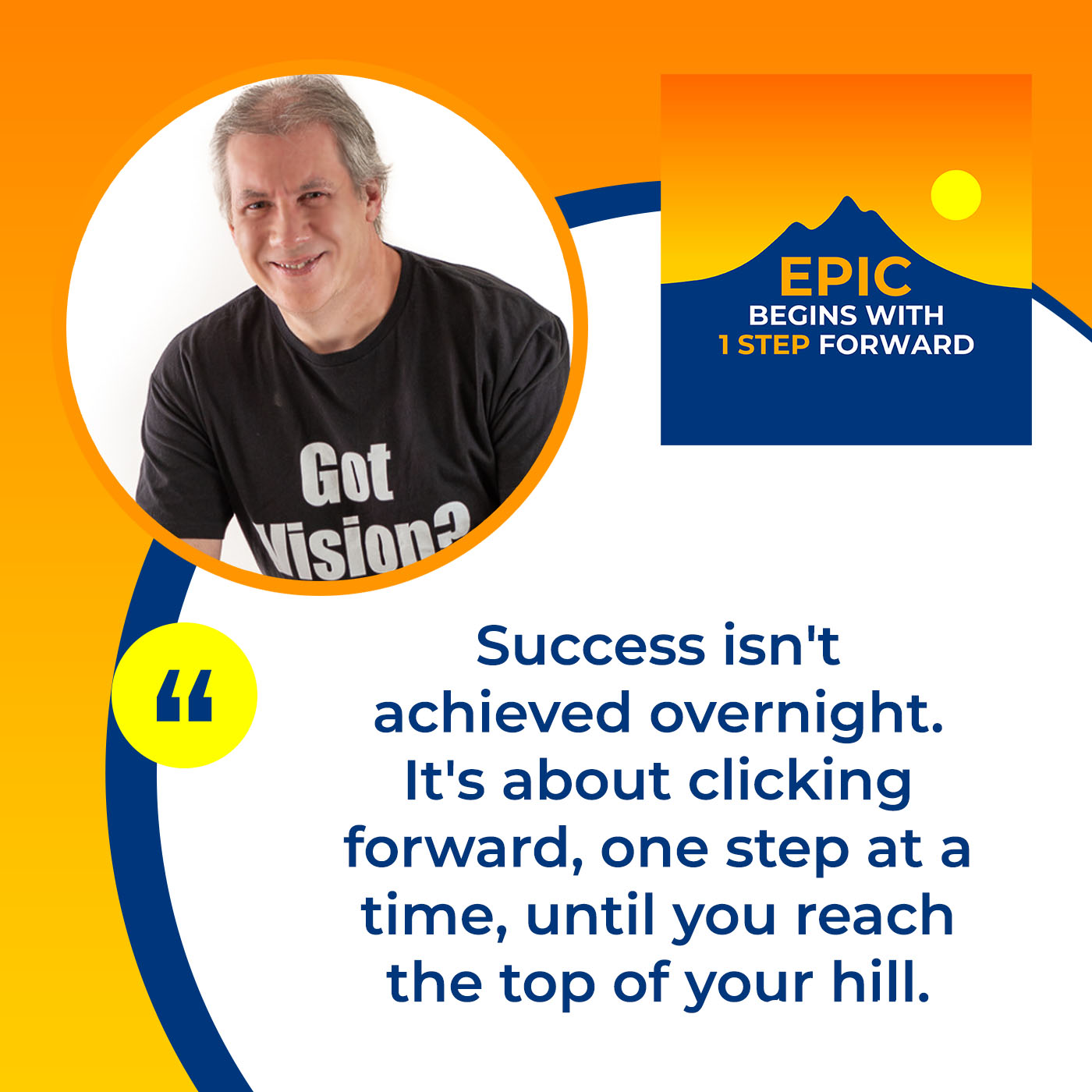
As scared as you might be, as nervous as you might be, as stuck as you might feel, every once in a while, if you look over your shoulder, you realize that because you’re being consistent, you’re actually getting better. You’re getting closer. At that last click that goes over the top, when you’ve done all the work, you get to scream your brains out and celebrate the fact that you achieved that goal, but you’ve got to do all that work. I still actually have the picture that I took that night in June of 2003 of that rollercoaster. It sat in my camera for about a year. I started telling the story. It’s the most requested story in my keynote presentations. It’s the old wooden rollercoaster.
I thought it would be bungee jumping off the stratosphere.
That one’s in there, too. That’s a lesson about overcoming fear.
It is. I get that. I’ve gone bungee jumping. It was a fantastic idea when I was paying for it, but I was on the edge. I discovered, and you obviously discovered, that you’re scared, but the fun is saying, “Let me go.” You have that. Our brains are amazing things, Steve. When I did my first bungee jump, I found that the thing that popped into my head first was, “There’s no turning back.” I’m fully committed to this. You can’t stop once you step off the edge. No matter what happens, you’re in for this ride.
My first thought was, “I can deduct this off my taxes.” I came up with a three-step approach to fear for me. First, identify exactly what you’re afraid of. It’s very rarely what we first think it is. My fear was that when the young lady who was operating the ride said, “Three, two, one, go,” I wouldn’t jump. That was my fear. If I don’t jump, I have a GoPro on my wrist.
All my friends are going to make fun of me because they’re going to see the edit in the video. They’d be like, “Steve sat there and wet his pants and cried like a little girl for fifteen minutes and edited that part out.” Then I thought, you know what? If you know exactly what you’re afraid of, find people who can guide you through it, people who have the experience, knowledge, mentorship, and coaching, whatever.
I thought she does this all day long with people. When she said “go,” and my wife, Tina, was down on the patio below, 108 floors below, someone asked her, “Did Steve just lean off the building?” She said, “No, he supermanned off the building.” I dove out as far as I could with the greatest smile and screamed my brains out with joy all the way down. I did deduct it off my taxes, which was an interesting explanation for my CPA, but he approved it and loved the story.
It’s a great story. I watched you telling it on your website, and I was like, “That’s great.” I was right there with you. I remember I happened to do it in Christchurch, New Zealand. I’d been over in Australia. When I was done studying, I was like, “I’m here. I’m over in this part of the world. Let me go explore.” I honestly went to New Zealand specifically to go bungee jumping. I did 163.5 feet.
I did not want to dunk in the water because it was glacial water, really cold. I was like, “No.” The funny thing is, there’s this video of me that they took when I got back up. I was one of the first people that day to go. You do your thing, and then they hand you a pole and lower you down into a boat. You had to walk up this dirt path, but as you might have experienced, there’s just a little bit of adrenaline running through your system.
I walked, ran, whatever. When I got up there, I was a little out of breath, and the adrenaline was pumping so hard that my voice was all weird. I was like, “That was great.” I was all twitchy and stuff. My friends watched it and were like, “What is the problem with you?” I said, “I just scared myself so bad. It was so awesome. I was so excited.” I do agree. Next time you do it, have that pizza box so that you freak out the people.
I’ve sworn to look at people with a pizza box duct-taped to my hand and ask them, “Is this yours?”
Steve, how are you bringing epic into your life and into your clients’ lives? I know you talk about vision. We see it right behind you. I’m fascinated by what you are doing.
The biggest thing that I work on with people is I honestly don’t believe, and I blame this firmly on our industry, personal development because there are too many gurus out there. People are being asked, “What do you really want?” Many people were lectured about what success is supposed to be all about. It could be different for every single one of us.
What do you want? Who do you want to become? Success is different for everyone—define it for yourself.
There are almost 8 billion of us on the planet, so I’ll ask people, “What would success mean to you? What do you want? Who do you want to become? What is the best thing you love about yourself? How can we magnify that and make it even better?” We just start to tell stories. I don’t ask them to write a list of their goals. I ask them for stories of their life. I watch them light up, and I say, “How can we bring more of that into your life?”
We start going through the life wheel, all the different areas, and how each one is actually connected. I ask them, and this is what stops them a little, and then they laugh when I get to the last one. I say, “What do your goals look like, feel like, sound like, taste like, and smell like?” My goal is smell. When we start to create the story of what it’s going to feel like when you’ve achieved this and the version of yourself you’ve become, I want you to walk me through the scenario of what’s going on.
For example, I handwrite my top ten goals every day in a journal in my office. The tenth one is, “I richly deserve and appreciate my #RedHotRide,” because I want to buy a new vehicle in the next year. I say, “I want to enjoy the safety, the comfort, the style, and the new truck smell of my new vehicle.” Anyone who’s ever bought a new vehicle knows what a new truck smell is.
Every day when I write that, I go. That’s what I do with my clients: create a full-on sensory experiential thing, which is much stronger because you’re also connecting to an emotional reason why you want this. It’s much stronger than just slapping a picture on a board and hoping for the best, which is what too many people out there think vision boards are all about.
Vision boards are a roadmap that says, “Here’s where I want to go.” Another thing that I think people get hung up on is, “I don’t have the full, I don’t have, I don’t know all the answers. I don’t know exactly where I have to go.” I try not to laugh too hard at that because I’m like, “No, you’re right. When you got up this morning, you didn’t know all the answers to all the questions you’re going to get today, but you still got up and started your day.” All you need to know is what that first step is.
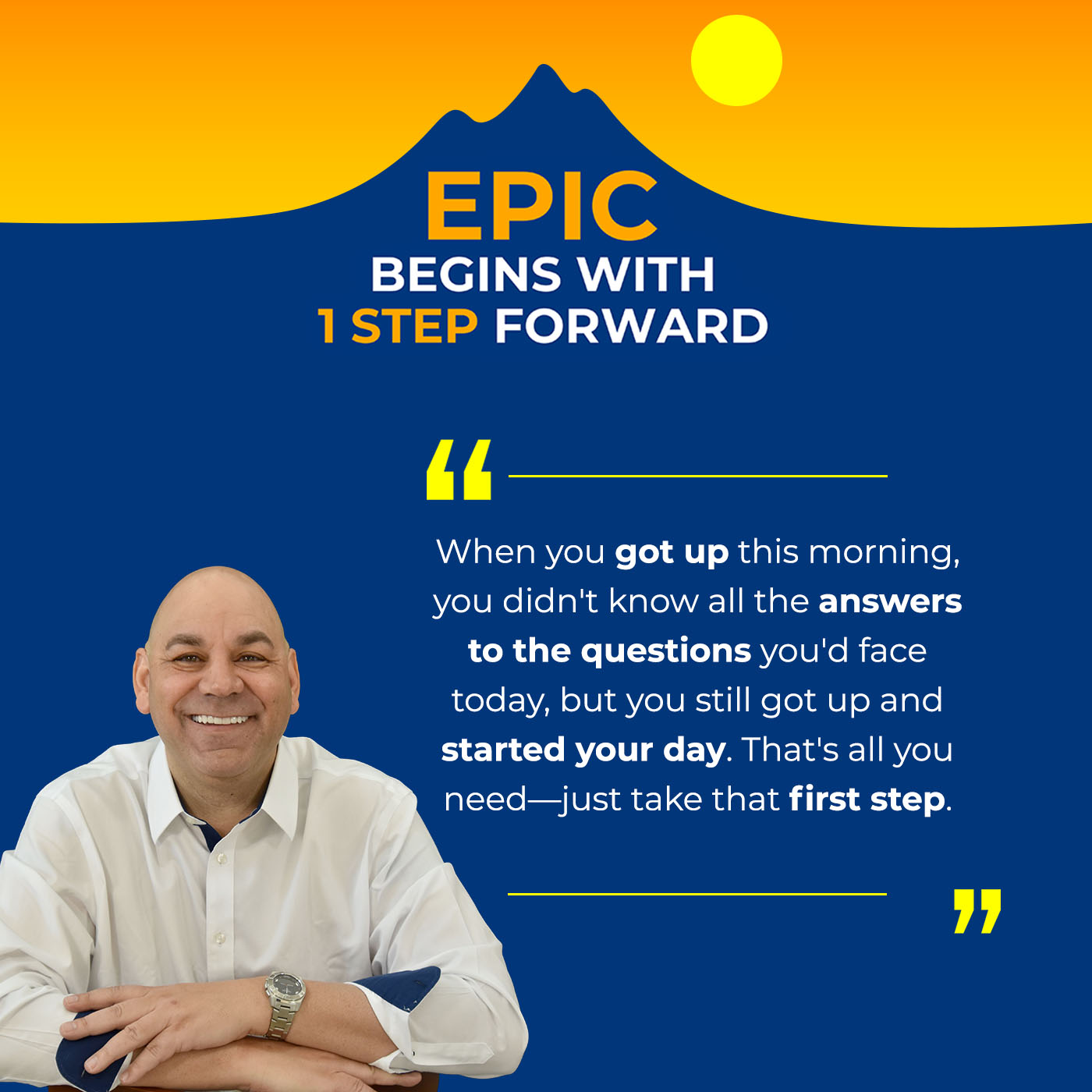
You can plan out and understand. I’ve done. My audience has heard me talk about my marathons a lot, but it’s always good. I’ve run ten halves, four fulls, and a 50K ultra. People ask, “How did you do that?” I’m like, “Psychology is really important because, let me tell you, 26.2 miles is a long way.” Again, break it down into achievable things. Along the way, my first goal was 13.1 because I ran half this marathon. It was mile seventeen because I only have single digits. I only have nine miles. It was mile twenty. I’ve already run twenty miles. It’s only 10K left. I got this. I count down my miles.
Psychologically, it’s so much easier. Let me tell you, I wish marathons, they didn’t put up the first-mile marker until about mile five because as hard as you try, Steve, like your rollercoaster, click, click. The first couple of clicks, you’re like, “There are a lot of clicks left.” You start to get less worried as you, I don’t know, say less worried as you get to the top.
Here’s another thing. We have these goals, and they’re awesome, but something funny happens. I crossed my first marathon and I was elated, but then I’m like, “But now what? I achieved this thing that I dreamed of, that I wanted to do, a bucket list thing. I’m really excited I did it, but now what?” That’s where the vision, you talk about vision, comes in. You don’t have to have the answer right away, but hopefully, it spurs you on to go, “If I can do this, maybe I want to go do it again. Maybe I want to try something different, but I’m possible.”
A hundred percent. I call that feeling that almost let me down at the end, once you’ve done it, the success hangover. We fought it for so long. All of a sudden, we did it and we’re like, “Now what?” My thought is, “You just nailed it perfectly. How can this, the fact that I overcame all those fears, did all the work, and achieved this, benefit all the other parts of my life? How can I tell that other version of me that might be scared to try something else? You did this.” I’m not a marathon runner. I’m a Peloton guy.
I love Peloton. I’ve been doing Peloton for years.
Steve’s Peloton Journey And Goals
I started in January of 2022. We got our Peloton, and on the first day, Allie Love was the instructor, who I absolutely adore. Three minutes in, I’m blotchy, I can’t breathe, my legs are cramping up, and the seat hurts my butt because it’s rock hard. At three minutes, I’m wheezing. All of a sudden, she goes, “That’s our warmup. We’ll go do the rest of the 30-minute ride.” I gave the screen the finger and then realized there was a camera there.
From that one day when I was struggling after three minutes, my goal is 3,000 total miles. It seems scary to a lot of people because it’s essentially the length across the country. I did some math. There are 366 days this year, so 3,000 divided by that comes out to 8.23 miles per calendar day that I need to pedal. That’s not bad. It takes me 23.5 minutes to do, by the way, because I figured it out and tracked this. Every day, I at least do that. I go a little further in case I miss a day. I only require myself to do Monday through Friday. Weekends are a bonus because I do other work for exercise, but I’m on such a tear, I’ll be celebrating 2,000 miles probably by the end of next week.
Having those little increments like you with your mile markers, we just keep going. I say, “click,” a lot when I’m on there. I’ll look at the mile and go, “Click.” Great music and this and that instructors. I love that I’m here. I got a fan on me because I sweat to death, and I love that part of my day. It’s helping me in every other part of my life by improving my physical health.
I love the Peloton. I ride a road bike. If you happen to look me up, I don’t have, even though I’ve had the bike for years, a ton of rides because I’m on my road bike, but I do love it. I actually started in 2015 or something, back when it was brand new. I like to say I’m OP, or Original Peloton, because when I went in, there might be 30 people in a class. I got to know a lot of the original instructors, Jenn Sherman, Christine D’ercole, Hannah Corbin. They’d go, “Zander30, so great to see you.” I actually had a chance to be in the top 10 or 15.
Obviously, you go into a class, and it’s great that Peloton is so popular, but you’re in there with 3,000 other people. There’s no way I’m like, “If I could just be in the top 50%, I feel I’m doing pretty good on it.” I love all that Peloton does. You’re absolutely right. You set this big, bold, audacious goal, but realize that you achieve it one step at a time. It is that first step forward. What you find is the first step is not nearly as hard as you imagined it would be. You have the confidence to go, “That was easy. What can I do?”
Absolutely have a plan. Structure is really important for any of us to achieve our goals. You created the structure, said, “How do I achieve this?” I need to ride 8.6 miles every day. I’ll pad it. If I miss a day, if I’m sick or traveling, I can’t do it.” As you said, it’s so achievable when you’re like, “I got to go do eight miles.” When I was training for my marathon, I joined Team in Training, which is a fundraising site for the Leukemia and Lymphoma Society. They handed me a training schedule. It just got so much easier because I’d look at it and go, “Go run for 30 minutes. On the weekend, go run fifteen miles.”
It went up, and then you go down a little, and then you go. What seemed harder, like, I have to go run five miles, became easier. I’m into the training, and they’re like, “You have a five-mile run today.” Only five miles? That’s okay. On Peloton, you’re like, as you said, dying after three minutes. You’re like, “I’m going to do a 45-minute class.” I’m feeling good. Before, you would have been like, “45 minutes? Get the defibrillators.”
You mentioned some of my favorite instructors. I actually took a Jenn Sherman class. It was phenomenal. I adore her.
I really love Christine. I love that Zen, close-your-eyes approach. There’s stuff that she used to say that I don’t think peaking is creepy, which is just like, “Shut your eyes. Focus. You don’t look at the screen. It doesn’t matter how fast you’re going.”
My wife and I are going on a trip to London this December 2024. Part of my goal while we’re there is to visit the Peloton offices and get a picture of myself, even in the lobby, because I don’t know if our schedule is going to allow me to take a class or what the schedule is going to be. I want to go there. If I happen to catch Ben and Leanne walking in or in the background, they are my two favorite British instructors. I take a stretch class with Ben every day and as many of Leanne’s cycle classes as possible. I would just love to get a picture with their logo and put that on the achievements of my vision board.
Here’s one thing. I did get to New York. I did get to do my 100th class with Christine in the studio. Riding in the studio is so much harder than at home. I don’t know why. Part of it is you don’t have a fan blowing on you. It’s hot, but it just seems like you’re doing great in our class and I’m really struggling. It is great.
How To Get In Touch With Steve Gamlin
Those Peloton instructors are all so fantastic. I’m sure people are like, “Stop talking about Peloton, you two,” but it is good. Exercise is so vital to all of the things that we want to do. When I first started, a running coach said, “You don’t regret a day that you took a run, but you do when you don’t.” I think if you missed a Peloton class, not for a good reason, but just because you’re tired or whatever, later on, you’re like, “I should have done it. I don’t feel as good.” I noticed. Steve, this has been fascinating. How can people get a hold of you and find out how to work with you?
They can find me on social media on other major platforms. Facebook, LinkedIn are the ones I’m on most, and YouTube as well. Just look up Steve Gamlin or visit my website, SteveGamlin.com.
Steve, I want to thank you so much for coming. Your words about the vision board and your awesome stories about the rollercoaster and bungee jumping were great. Also connecting about Peloton because it is super fun.
We’re all part of the cult, as I sometimes get called.
It really is.
It’s the greatest cult on earth that I’ve ever been a part of. It’s the only one I’ve ever been a part of, but it is phenomenal. Thank you so much for having me, Zander. I appreciate it. This has been a blast.
To all of my readers, remember you can find all the information you want about me at EpicBegins.com. As always, remember that epic choices lead to the epic life that you want.
Important Links
- Steve Gamlin
- Facebook – Steve Gamlin
- LinkedIn – Steve Gamlin
- YouTube – Steve Gamlin
About Steve Gamlin
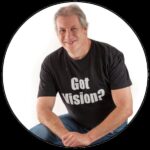 As a Keynote Speaker and Visualization Coach, Steve Gamlin helps frustrated entrepreneurs stop ‘Hustling & Grinding’ to find purpose in their lives, through his proprietary Vision Board Mastery Method.
As a Keynote Speaker and Visualization Coach, Steve Gamlin helps frustrated entrepreneurs stop ‘Hustling & Grinding’ to find purpose in their lives, through his proprietary Vision Board Mastery Method.
